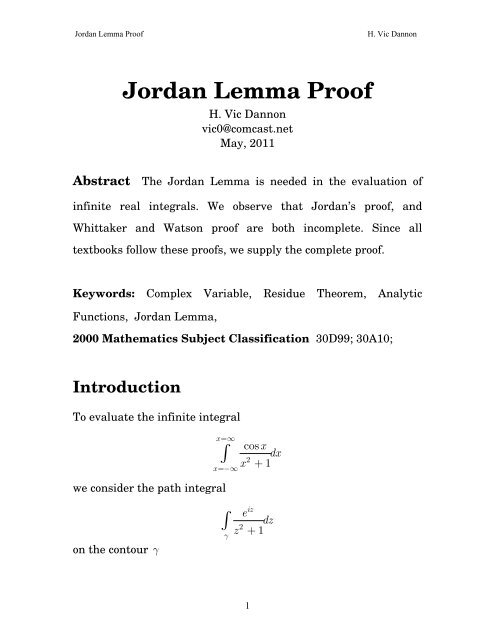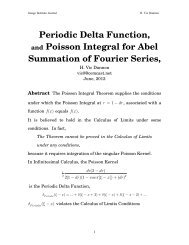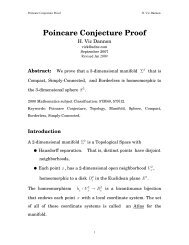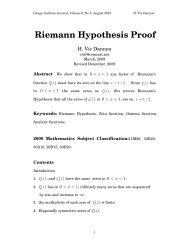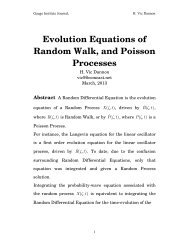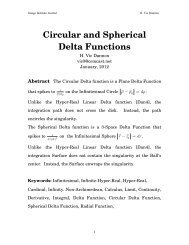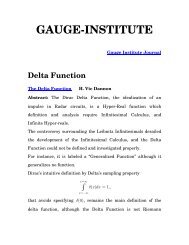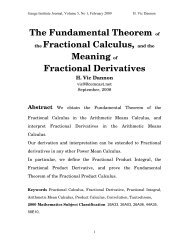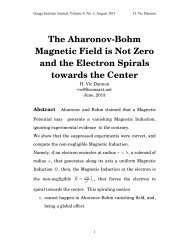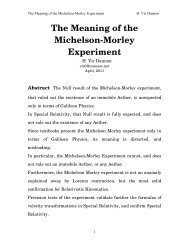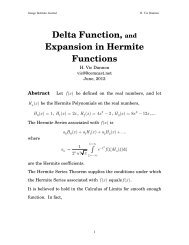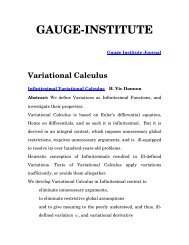Jordan Lemma Proof - Gauge-institute.org
Jordan Lemma Proof - Gauge-institute.org
Jordan Lemma Proof - Gauge-institute.org
Create successful ePaper yourself
Turn your PDF publications into a flip-book with our unique Google optimized e-Paper software.
<strong>Jordan</strong> <strong>Lemma</strong> <strong>Proof</strong><br />
H. Vic Dannon<br />
<strong>Jordan</strong> <strong>Lemma</strong> <strong>Proof</strong><br />
H. Vic Dannon<br />
vic0@comcast.net<br />
May, 2011<br />
Abstract The <strong>Jordan</strong> <strong>Lemma</strong> is needed in the evaluation of<br />
infinite real integrals. We observe that <strong>Jordan</strong>’s proof, and<br />
Whittaker and Watson proof are both incomplete. Since all<br />
textbooks follow these proofs, we supply the complete proof.<br />
Keywords: Complex Variable, Residue Theorem, Analytic<br />
Functions, <strong>Jordan</strong> <strong>Lemma</strong>,<br />
2000 Mathematics Subject Classification 30D99; 30A10;<br />
Introduction<br />
To evaluate the infinite integral<br />
x =∞<br />
we consider the path integral<br />
∫<br />
cosx dx<br />
1<br />
2<br />
x +<br />
x =−∞<br />
on the contour γ<br />
∫<br />
e iz<br />
2<br />
z +<br />
γ<br />
dz<br />
1<br />
1
<strong>Jordan</strong> <strong>Lemma</strong> <strong>Proof</strong><br />
H. Vic Dannon<br />
with ρ →∞.<br />
On the semi-circle,<br />
e iz<br />
∫ dz → 0 , as ρ →∞.<br />
2<br />
z + 1<br />
Therefore, by the Residue Theorem,<br />
x =∞<br />
∫<br />
x =−∞<br />
∩<br />
ix<br />
iz<br />
e<br />
⎧<br />
e ⎫<br />
dx = 2πiRes ⎪<br />
⎨<br />
⎪<br />
⎬<br />
2<br />
x + 1<br />
⎪⎩<br />
( z + i )( z −i<br />
)<br />
⎪⎭<br />
⎧<br />
iz<br />
e ⎫<br />
= 2πi<br />
lim⎪<br />
⎨<br />
⎪<br />
⎬<br />
z→i<br />
⎪⎩z<br />
+ i<br />
⎪⎭<br />
= πe<br />
−<br />
It follows that this is the value of the desired integral.<br />
The vanishing of the integral on the infinite semi-circle, holds<br />
under the conditions of a general result attributed by Whittaker<br />
and Watson, to <strong>Jordan</strong>.<br />
1<br />
.<br />
z=<br />
i<br />
z=<br />
i<br />
If f () z is an analytic function in the upper-half complex plane,<br />
so that f () z → 0<br />
, uniformly on any upper semi-circle C with<br />
ρ<br />
radius<br />
ρ →∞, centered at the origin,<br />
2
<strong>Jordan</strong> <strong>Lemma</strong> <strong>Proof</strong><br />
H. Vic Dannon<br />
∫<br />
imz<br />
Then, for m > 0 , e f() z dz → 0, as ρ →∞.<br />
C<br />
ρ<br />
We show here that the proof of the <strong>Lemma</strong> by <strong>Jordan</strong>, and the<br />
proof by Whittaker and Watson are incomplete.<br />
Whittaker and Watson proof permeates many if not all textbooks<br />
on complex variables, and has to be corrected.<br />
1. <strong>Jordan</strong>’s <strong>Proof</strong><br />
In <strong>Jordan</strong>’s proof, m = 1.<br />
On the semi-circle, C<br />
ρ<br />
We have<br />
z<br />
i<br />
e θ<br />
= ρ , 0 ≤ θ ≤ π.<br />
iz<br />
iz<br />
∫ e f() z dz ≤ ∫ e f()<br />
z dz .<br />
C<br />
ρ<br />
C<br />
ρ<br />
Substituting<br />
iz<br />
iρcos θ−ρsin θ −ρsin<br />
θ<br />
e = e = e ,<br />
dz<br />
i θ<br />
= ρe dθ,<br />
dz<br />
= ρθ d ,<br />
θ=<br />
π<br />
iz<br />
∫ e f() z dz ≤ max f()<br />
z ρ∫ −ρsin<br />
θ<br />
e dθ.<br />
C<br />
C θ=<br />
0<br />
ρ<br />
ρ<br />
Since<br />
3
<strong>Jordan</strong> <strong>Lemma</strong> <strong>Proof</strong><br />
H. Vic Dannon<br />
max f ( z) → 0, as ρ →∞,<br />
C<br />
ρ<br />
we need to show that<br />
ρ<br />
θ=<br />
π<br />
∫<br />
θ=<br />
0<br />
e<br />
−ρsin<br />
θ<br />
dθ<br />
is bounded.<br />
<strong>Jordan</strong> writes with no further explanation<br />
θ=<br />
π<br />
θ=<br />
∫<br />
−ρsin<br />
θ<br />
e d ≤ 2 ∫<br />
−ρsin<br />
θ<br />
e dθ, (1)<br />
θ= 0 θ=<br />
0<br />
ρ θ ρ<br />
π<br />
2<br />
and proceeds to bound<br />
ρ<br />
π<br />
2<br />
θ=<br />
−ρsin<br />
θ<br />
∫ e d θ, by π 2<br />
.<br />
θ=<br />
0<br />
Now, since<br />
the claim (1) amounts to<br />
π<br />
2<br />
θ= π θ=<br />
θ=<br />
π<br />
−ρsin θ −ρsin θ −ρsin<br />
θ<br />
∫ e dθ<br />
= ∫ e dθ<br />
+ ∫ e dθ,<br />
θ= 0 θ= 0<br />
θ=<br />
θ=<br />
π<br />
θ=<br />
∫<br />
−ρsin<br />
θ<br />
e dθ<br />
≤ ∫<br />
−ρsin<br />
θ<br />
e dθ.<br />
θ=<br />
θ=<br />
0<br />
π<br />
2<br />
Changing the integration variable in the first integral into<br />
π<br />
2<br />
π<br />
2<br />
we have<br />
and<br />
φ<br />
= θ − ,<br />
π<br />
2<br />
sin(<br />
π<br />
− sin − ρ φ+<br />
)<br />
e e<br />
2<br />
e<br />
ρ θ −ρcos<br />
φ<br />
= = ,<br />
4
<strong>Jordan</strong> <strong>Lemma</strong> <strong>Proof</strong><br />
H. Vic Dannon<br />
π<br />
θ<br />
π<br />
2 2<br />
φ= =<br />
∫<br />
−ρcosφ e dφ<br />
≤ ∫<br />
−ρsin<br />
θ<br />
e d θ.<br />
φ= 0 θ=<br />
0<br />
That is,<br />
π<br />
θ<br />
π<br />
2 2<br />
θ= =<br />
∫<br />
−ρcosθ e dθ<br />
≤ ∫<br />
−ρsin<br />
θ<br />
e d θ.<br />
θ= 0 θ=<br />
0<br />
Since this inequality is un-established, <strong>Jordan</strong> <strong>Proof</strong> is incomplete.<br />
2. Whittaker and Watson <strong>Proof</strong><br />
Where <strong>Jordan</strong> saw an inequality, Whittaker and Watson saw an<br />
equality. They wrote with no further explanation<br />
θ=<br />
π<br />
θ=<br />
∫<br />
−mρsin<br />
θ<br />
e d = 2 ∫<br />
−mρsin<br />
θ<br />
e dθ, (2)<br />
θ= 0 θ=<br />
0<br />
ρ θ ρ<br />
θ=<br />
−mρsin<br />
θ<br />
and proceeded to bound ρ∫ e d θ, by π 2m<br />
.<br />
Now, since<br />
π<br />
2<br />
θ=<br />
0<br />
π<br />
2<br />
θ= π θ=<br />
θ=<br />
π<br />
−mρsin θ −mρsin θ −mρsin<br />
θ<br />
∫ e dθ<br />
= ∫ e dθ<br />
+ ∫ e dθ,<br />
θ= 0 θ= 0<br />
θ=<br />
their claim (2) leads to<br />
π<br />
2<br />
π<br />
θ<br />
π<br />
2 2<br />
θ= =<br />
∫<br />
−mρcos<br />
θ<br />
e dθ<br />
= ∫<br />
−mρsin<br />
θ<br />
e d θ.<br />
θ= 0 θ=<br />
0<br />
This is un-established, and Whittaker-Watson <strong>Proof</strong> is incomplete.<br />
π<br />
2<br />
5
<strong>Jordan</strong> <strong>Lemma</strong> <strong>Proof</strong><br />
H. Vic Dannon<br />
3.<br />
θ=<br />
∫<br />
π<br />
2<br />
θ=<br />
0<br />
e<br />
−mρcos<br />
θ<br />
d θ, and<br />
θ=<br />
∫<br />
π<br />
2<br />
θ=<br />
0<br />
e<br />
−mρsin<br />
θ<br />
d θ by MAPLE<br />
Using<br />
in MAPLE, we obtain<br />
Using<br />
in MAPLE, we obtain<br />
Thus, an equality of areas under the graphs may be due to<br />
symmetry of the graphs. But we cannot confirm it, because do not<br />
know how to evaluate the integrals.<br />
6
<strong>Jordan</strong> <strong>Lemma</strong> <strong>Proof</strong><br />
H. Vic Dannon<br />
In MAPLE, we confirm that<br />
and<br />
θ=<br />
∫<br />
π<br />
2<br />
θ=<br />
0<br />
θ=<br />
∫<br />
π<br />
2<br />
θ=<br />
0<br />
e<br />
e<br />
−2cosθ<br />
−2cosθ<br />
dθ<br />
dθ<br />
=<br />
=<br />
(1/2)*Pi*BesselI(0, 2)-(1/2)*Pi*StruveL(0, 2)<br />
(1/2)*Pi*BesselI(0, 2)-(1/2)*Pi*StruveL(0, 2)<br />
In the notations of Abramowitz, and Stegun<br />
BesselI(0, 2)=Modified Bessel Function I<br />
0(2)<br />
StruveL(0, 2)=Struve Function L (2) .<br />
That is, both integrals equal<br />
π<br />
( 0(2) 0(2)<br />
)<br />
2 I − L .<br />
This confirms Whittaker’s guess of equality.<br />
Nevertheless, it seems easier to complete the <strong>Jordan</strong> <strong>Lemma</strong> <strong>Proof</strong><br />
by bounding<br />
θ=<br />
∫<br />
π<br />
2<br />
θ=<br />
0<br />
e<br />
−mρcosθ<br />
0<br />
d θ, then by trying to prove the equality.<br />
4. Completed <strong>Proof</strong><br />
To complete the <strong>Jordan</strong> <strong>Lemma</strong> <strong>Proof</strong>, we need to bound<br />
ρ<br />
θ=<br />
∫<br />
π<br />
2<br />
θ=<br />
0<br />
e<br />
−ρcos<br />
θ<br />
dθ, similarly to the bounding of<br />
ρ<br />
π<br />
2<br />
θ=<br />
−ρsin<br />
θ<br />
∫ e dθ.<br />
θ=<br />
0<br />
7
<strong>Jordan</strong> <strong>Lemma</strong> <strong>Proof</strong><br />
H. Vic Dannon<br />
The cord between the endpoints over the interval<br />
π<br />
0 ≤ θ ≤<br />
2<br />
has the slope<br />
and its equation is<br />
cos − cos 0 2<br />
=− ,<br />
− 0 π<br />
π<br />
2<br />
π<br />
2<br />
2<br />
y − 1 = − θ .<br />
π<br />
Since<br />
cosθ<br />
is concave down in<br />
π<br />
0 θ<br />
2<br />
≤ ≤ , the cord between the<br />
endpoints is under the graph of<br />
cosθ . That is,<br />
Therefore,<br />
and<br />
2<br />
cos θ ≥ y = 1 − θ.<br />
π<br />
2<br />
−cos θ ≤ − 1 + θ,<br />
π<br />
=<br />
π<br />
θ=<br />
π<br />
2 2<br />
2<br />
mρ( −cos θ)<br />
− mρ+<br />
mρ θ<br />
e d ≤ e<br />
π<br />
∫ ∫ dθ<br />
θ<br />
ρ θ ρ<br />
θ= 0 θ=<br />
0<br />
θ=<br />
π<br />
2<br />
1 m<br />
= ρ<br />
mρ<br />
∫<br />
e<br />
θ=<br />
0<br />
e<br />
2<br />
π<br />
ρ θ<br />
dθ<br />
8
<strong>Jordan</strong> <strong>Lemma</strong> <strong>Proof</strong><br />
H. Vic Dannon<br />
2<br />
π<br />
2 θ<br />
π<br />
2<br />
π<br />
=<br />
1 1 mρ θ<br />
= ρ e<br />
mρ<br />
e m ρ<br />
θ=<br />
0<br />
mρ<br />
2 π<br />
2<br />
( e<br />
π<br />
1)<br />
1 1 π<br />
= −<br />
mρ<br />
e m 2<br />
π ⎛ 1 ⎞<br />
= 1<br />
⎜<br />
− 2m<br />
⎜⎝<br />
m<br />
⎠⎟<br />
π<br />
≤ .<br />
2m<br />
e ρ<br />
Similarly, [Whittaker and Watson],<br />
ρ<br />
θ=<br />
∫<br />
π<br />
2<br />
θ=<br />
0<br />
e<br />
−ρsin<br />
θ<br />
dθ is bounded by<br />
π , and<br />
2m<br />
π<br />
π<br />
θ=<br />
π<br />
θ= θ=<br />
2 2<br />
ρ e dθ = ρ e dθ + ρ e<br />
∫<br />
−ρsin θ<br />
∫<br />
−ρsin θ<br />
∫<br />
−ρcosθdθ<br />
θ= 0 θ= 0 θ=<br />
0<br />
is bounded by m<br />
π .<br />
References<br />
[<strong>Jordan</strong>] <strong>Jordan</strong>, M. C., Cours D’ANALYSE de L’Ecole Polytechnique, Tome<br />
Deuxieme, Calcul Integral, Gauthier-Villars, 1894, pp. 285-286<br />
[Whittaker and Watson] Whittaker, E. T., and Watson G. N., A Course of Modern<br />
Analysis, Fourth Edition, Cambridge University press, 1927. p. 115.<br />
[Abramowitz and Stegun] Abramowitz Milton, and Stegun, Irene, Handbook of<br />
Mathematical Functions, National Bureau of Standards Applied Mathematics<br />
Series, May 1958<br />
9


